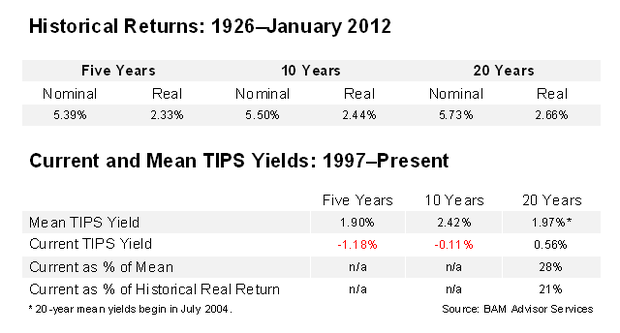Inflation: Swedroe's monthly TIPS update
(MoneyWatch) On a monthly basis, I update the tables below to help you make decisions on purchasing Treasury inflation-protected securities. The data is as of March 15.
The first table provides the historical data on the real return of "nominal" Treasury bonds from 1926 through January. The second table shows the current and mean TIPS yields.
Since last month's update, 10- and 20-year TIPS yields have risen, while the short end remains fairly unchanged. The 10-year TIPS yield is now -0.11 percent, and the 20-year is up to 0.56 percent. In both cases, it's an increase of 0.15 percent. Nominal Treasury yields have had an even greater increase. The 10-year has risen to 2.27 percent (an increase of 0.25 percent), and the 20-year yield has risen to 3.03 percent (up 0.26 percent). This increased the 10-year and 20-year break-even rates to 2.38 percent and 2.47 percent, respectively. At the beginning of the year, the 10-year break-even was only 1.95 percent.
The first-quarter inflation estimate from the Philadelphia Federal Reserve released last month is 2.3 percent over the next 10 years, down from last quarter's estimate of 2.5 percent. The risk premium for unexpected inflation (the difference between the headline CPI estimate from the Philadelphia Fed forecasters and the break-even rate between nominal Treasuries and TIPS) on 10-year nominal bonds increased slightly from -0.03 percent to 0.08 percent over the past month. This means that the risk premium for unexpected inflation is slightly positive for the first time in a while. On the surface, this would slightly favor nominal Treasuries over TIPS. However, investors who are averse to the risks of unexpected inflation should still prefer TIPS over nominal Treasuries of the same maturity.
The Philadelphia Fed's first-quarter, five-year inflation forecast is 2.3 percent. Five-year nominal Treasuries now yield 1.09 percent, which makes the expected real return -1.21 percent, an increase of 0.21 percent from last month. The market break-even rate between Treasuries and TIPS is 2.27 percent, which means a -0.03 percent risk premium, using the Philadelphia Fed estimate. This means that five-year TIPS are more attractive than nominal five-year Treasuries.
As indicated above, the TIPS curve steepened over the past month. The shorter maturities remained mostly unchanged, while the 10-year and 20-year maturity yields increased around 0.15 percent. Although real yields remain close to their historic lows, it could make sense to extend to the 10-to-15-year maturities. Currently, by extending from the five-year TIPS to 10-year TIPS, there's a 1.06 percent yield pick-up (or about 0.21 percent per year). This is up from 0.18 percent per year last month.
Extending another five years gives you around 0.09 percent per year, and beyond that around 0.07 percent per year. For now, to get positive real yields investors would have to extend to the 2025 maturity (0.17 percent).
As we have mentioned last month, TIPS yields are still well below their historic averages. Therefore, investors disinclined to subject their portfolios to additional price risk might find it more prudent to limit maturities to about 10 years. However, the current 10-year TIPS is only a 0.125 percent coupon. A low-coupon bond will generally have greater price risk than one of a similar maturity with a bigger coupon. An alternative to buying the current 10-year TIPS would be to extend another three years to the 13-year TIPS. It has a 2.375 percent coupon and captures an additional 0.30 percent of real yield. The maturity extension will add to the price risk, but the bigger coupon will help to dampen this volatility, and you pick up the 0.30 percent in incremental yield.
While TIPS yields don't look attractive relative to historical averages, you can't buy yesterday's yields, only today's. And since our crystal balls are always cloudy, we can't know if the current yield on longer-term TIPS will look like good or bad 10 years or more in the future.
As always, one last point to remember is that one of the advantages of TIPS over nominal bonds is that you can take maturity risk with TIPS and earn the term premium without taking inflation risk. So while longer-term TIPS have more interim price risk -- which for some investors could be too much volatility to stomach -- there's no risk of loss if you hold to maturity.
Summarizing, it still seems prudent to limit maturities to about 10 years or so, since absolute yields are well below levels that would make longer-term TIPS a compelling buy regardless of the shape of the yield curve. If real rates rise well above the historical averages, you should consider locking in the higher yields for as long as possible, regardless of the shape of the yield curve. Higher TIPS yields would provide the added benefit of allowing you to lower your equity allocation, reducing the risk of the overall portfolio without lowering expected returns.
